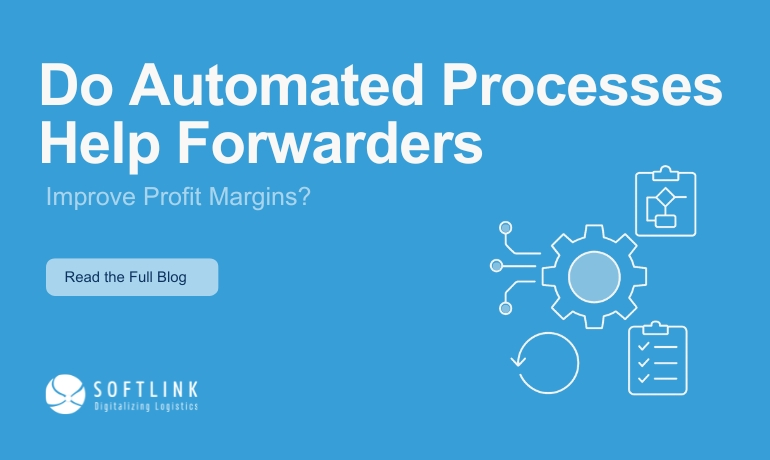- By Softlink Global
- May 12, 2025
- General
The freight forwarding industry has never operated on wide margins. Even before the pandemic, volatile fuel prices, rising compliance burdens, and customer service demands meant most forwarders worked with tight cost controls and little room for error. Today, with growing competition and global disruptions still looming, improving profit margins requires a different approach—one that’s focused not just on growth, but on operational efficiency.
This is where automation proves its worth. Automated processes help forwarders simplify complexity, reduce manual overhead, avoid costly delays, and unlock faster decision-making—all of which directly affect profit margins. But how exactly does this work?
Let’s explore the operational areas where automation makes the most impact—and why it matters more than ever.
1. Reduced Manual Work and Cost Overhead
Forwarders spend considerable time on job creation, document generation, and shipment coordination. Without automation, these tasks require repeated data entry, multiple validations, and extensive coordination between teams. The result? Slower turnaround times, higher labor costs, and inconsistent output.
Automated freight software streamlines this entire flow. Once a booking is confirmed, job cards, BLs, AWBs, invoices, and shipment instructions can be generated automatically. Admin permissions, audit workflows, and real-time updates ensure accountability without micromanagement.
Why it matters: The same operations team can now manage more shipments in less time—without increasing headcount.
2. Fewer Errors, Fewer Revenue Leaks
In a manual setup, one small error—say, a misclassified HS code or incorrect cost entry—can lead to penalties, payment delays, or compliance issues. Over time, these micro-errors snowball into serious revenue leaks.
Automation helps reduce this risk. By using pre-configured rules, integrated document templates, and system-driven validations, freight forwarders can ensure greater accuracy across job costing, documentation, and compliance filings.
Why it matters: It’s not just about avoiding fines—it’s about ensuring that every service is correctly billed and accounted for.
3. Faster Quote-to-Cash Cycle
Slow invoicing is one of the most common bottlenecks in freight businesses. When billing is handled manually, it often gets delayed by missing cost details, manual approvals, or back-and-forth between departments.
Automated systems enable real-time job costing and auto-triggered invoicing. When a shipment is completed, the system knows the exact charges, applies the correct tariffs, and generates a compliant invoice with minimal delay.
Why it matters: Faster invoicing leads to faster collections, healthier cash flow, and improved working capital management.
Learn more from our experts how you can digitalize your freight forwarding & logistics business.
4. Scalability Without Linear Cost Growth
As business grows, so does the complexity—unless automation absorbs the scale. That’s the real test. Many forwarders struggle to scale profitably because their processes don’t scale with them.
Modern freight software allows forwarders to process more shipments, manage more clients, and coordinate across multiple geographies—without expanding teams or infrastructure at the same pace. Whether handling 100 jobs or 1,000, the effort stays relatively consistent.
Why it matters: True margin growth happens when revenue increases, but costs don’t rise proportionally.
5. Improved Customer Experience Without Manual Load
High service expectations can easily burden operations teams. Clients expect instant updates, document access, and proactive notifications—but responding to every query manually is unsustainable.
Self-service portals, automated tracking updates, and email notifications keep clients informed without overloading internal staff. Forwarders offering these features not only save time but also stand out competitively.
Why it matters: Smoother customer experience improves retention and reduces churn—protecting recurring revenue at scale.
6. Better Margin Visibility Through Analytics
You can’t improve what you can’t see. Without visibility into shipment-wise profitability or agent performance, many forwarders operate reactively. Spreadsheets and siloed systems can’t offer real-time insights.
Automated platforms centralize operational and financial data, giving leadership dashboards that highlight cost overruns, underperforming routes, or high-margin opportunities.
Why it matters: It turns profitability into a proactive goal, not a quarterly surprise.
What to Look for in a Freight Software Platform
If automation is the strategy, freight software is the enabler. But not all systems are equal. Forwarders should look for platforms that offer:
- End-to-end job management across air, sea, and land freight
- Auto-generated documentation (BL, AWB, invoices, etc.)
- Integrated cost/revenue tracking per job
- Sales & CRM tools with quoting automation
- Customer portals and real-time alerts
- Analytics dashboards for profitability and performance
- A solution that makes consistent innovations
- A solution that’s scalable with your business
Where Softlink Global Fits In
At Softlink Global, we’ve worked with forwarders of all sizes to help simplify operations, improve control, and support sustainable growth. Our platform, Logi-Sys, is an Intelligent Cloud ERP designed to be the digital backbone of freight forwarding businesses.
While the right automation strategy depends on your specific goals, Logi-Sys supports margin improvement through:
- Automated job creation, cost codes, and billing workflows
- Self-service customer portals for tracking and document access
- Integrated quoting and CRM tools to improve conversion
- Real-time profitability reports and business intelligence
- Scalable freight management across air, sea, and land
Logi-Sys is already helping forwarders in over 50 countries handle complexity without compromising profitability.
Final Word
Profit margins in freight forwarding are under constant pressure—but the solution isn’t just about cutting costs. It’s about working smarter.
Automation gives forwarders the tools to reduce overhead, avoid errors, bill faster, and scale without burning out their teams. The result? Greater control over operations and a direct path to sustainable profitability.
If you want your business to do more with less—and grow without growing costs—automation is where that journey begins.


